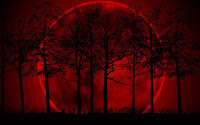Horror films are designed to:
* Frighten & panic
* Cause dread & alarm
* Evoke hidden fears
* Often conclude in a terrifying shocking finale
As horror films are typically quite intense, The opening shot for the title sequence could be an extreme close up of a character or vital prop, to which the camera will pan outwards to reveal the full establishing shot. Flickering lighting creates a sinister mood which can feature throughout the entirety of the sequence, or the lighting can flicker to transition into the next shot.

Imagery and visuals including blood, weapons, body parts, skulls, monsters, creatures and the devil are all common in horror films.

 Sound effects such as loud crashes, lightening strikes, screaming and heavy rain would be useful to create jump scares and alarm the audience. The soundtrack of the sequence could be sinister, moody or instrumental music to add to the dark atmosphere. However, dark and sinister visuals contrasted against sweet or childlike music can give a disturbing effect.
Sound effects such as loud crashes, lightening strikes, screaming and heavy rain would be useful to create jump scares and alarm the audience. The soundtrack of the sequence could be sinister, moody or instrumental music to add to the dark atmosphere. However, dark and sinister visuals contrasted against sweet or childlike music can give a disturbing effect.The overall sequence should be quite dimly lit and gloomy so that a white font can be contrasted over it. The font can be hand written or be dripping in blood to give a dark feel to the overall sequence allowing the font to tie in seamlessly.








 Omara recording bin scene by using a fig rig, so that the shot would be less shakey.
Omara recording bin scene by using a fig rig, so that the shot would be less shakey.


 Omara and Maria recording the locker panning shot.
Omara and Maria recording the locker panning shot. 


 Omara recording a shot of the hallway while Maria and Teddy silently watch.
Omara recording a shot of the hallway while Maria and Teddy silently watch. 








